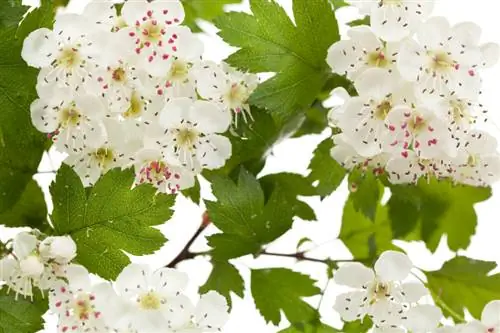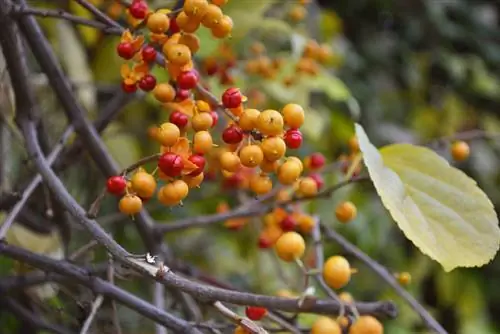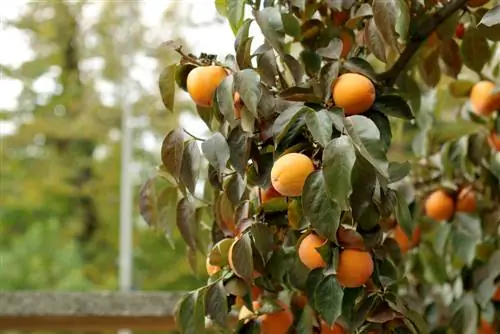- Author admin [email protected].
- Public 2023-12-16 16:46.
- Last modified 2025-06-01 06:02.
Read a commented tree shrike profile here with information on growth, leaves, flowers and fruit. Tried-and-tested tips explain how to properly plant and care for the Celastrus climbing shrub.

What is a tree shrike and how do you use it in the garden?
Tree shrike (Celastrus orbiculatus) is a deciduous climbing shrub from East Asia that can grow up to 12 meters high. It has round, elliptical leaves and inconspicuous flowers that produce a yellow-orange capsule fruit. Preferred uses are facade greening, privacy screens and ground cover.
Profile
- Scientific name: Celastrus orbiculatus
- Family: Spindle tree family (Celastraceae)
- Synonym: Round-leaved tree shrike
- Origin: East Asia
- Growth type: deciduous climbing shrub
- Growth height: 8 m to 12 m
- Leaf: rounded to elliptical
- Flower: inconspicuous
- Fruit: Capsule
- Toxicity: not poisonous
- Winter hardiness: hardy
- Use: facade greening, privacy screen, ground cover
Growth
Tree shrike is a deciduous, woody climbing plant from the spindle tree family (Celastraceae). Celastrus orbiculatus comes from the temperate climate zone of East Asia, where it is widespread in mixed forests and thickets. With its twining tendrils, the climbing shrub teaches trees to fear by mercilessly putting them in a headlock and sapping the lifeblood. In this country, the tree shrike is valued as an ornamental plant thanks to these growth characteristics:
- Growth habit: left-winding, deciduous climbing plant with golden-yellow autumn color and bright yellow-orange fruits.
- Growth height: 800 cm to 1200 cm.
- Growth width: 400 cm to 800 cm.
- Growth speed: 30 cm to 150 cm annual growth.
- Roots: Shallow roots
- Branches: round-stalked, initially herbaceous green, later with brown to gray-brown bark and inconspicuous cork pores.
- Ghorticulturally interesting properties: decorative surface planter (horizontal and vertical), easy to care for, tolerates cutting, hardy, dioecious, non-toxic, bee-friendly.
Video: Tree shrike in a short portrait
Leaf
Most of the year, an opaque foliage covers the woody climbing shoots. Only late in autumn does the hardy round-leaved tree shrike say goodbye to its well-deserved growth rest with beautiful autumn color. You can read interesting leaf characteristics here:
- Leaf shape: short-stemmed, broadly oval to egg-shaped, pointed, serrated leaf edge.
- Leaf size: 5 cm to 14 cm long, 3 cm to 10 cm wide.
- Leaf color: pale green to blue-green bare top and bottom, rarely with sparse hair on the leaf veins.
- Autumn color: golden yellow to reddish.
- Arrangement: alternate
Bloom
Tree shrike shrubs are generally unisexual and dioecious. The individual climbing bush bears either male or female flowers. Hermaphrodite individuals are rare. A tree shrike reveals its floral gender at the earliest when the first flowering period begins. All the important flower characteristics in a nutshell:
- Inflorescence: 1 cm to 3 cm long umbel of five-tiered greenish to greenish-white individual flowers.
- Single male flower: triangular sepals, ovoid petals (3-4 mm long, 2-2.5 mm wide), short stamens.
- Single female flower: smaller calyx than the male, ovary spherical, style 1.5 mm long, stigma 3-fold lobed.
- Flowering time: May to June.
In the fleshy flower base there are numerous nectar glands as a reward for hard-working insects as pollinators. For this reason, round-leaved tree shrike is classified as a bee pasture.
Fruit
Female tree shrikes delight in autumn with these pretty fruits:
- Fruit shape: spherical folding fruit with 3 compartments and an average of 3 (1-6) seeds.
- Fruit size: 8 mm to 14 mm long.
- Fruit color: yellow-orange pericarp.
- Fruit ripeness: July to October.
Ripe tree shrike fruits open up and reveal the 5 mm small seeds in the red aril (seed coat). The decorative fruit shoots have a long shelf life until well into winter. Garden birds appreciate the fruits as a source of food. However, tree shrike fruits are inedible for humans.
Usage
If you take the tree shrike's martial activities into account with appropriate precautions, you will discover numerous possible uses. May the following table inspire the hobby gardener's imagination for creative design ideas with the round-leaved tree shrike:
| with climbing aid | without climbing aid |
|---|---|
| Wall greening | Groundcover |
| Privacy protection | Embankment reinforcement |
| Soundproofing | Underplanting in the forest garden |
| Object greening: | Planting a garden on a hillside |
| + Round arch | Beautify tree trunk |
| + Pergola | Planting Benje hedge |
| + Arcade | green the old wall |
Tree shrike (Celastrus) and wisteria (Wisteria) are the dream team for the magnificent green facade. Anyone who associates these two bushes with a stable climbing aid will enjoy the picturesque wisteria blossoms in spring and the tree shrike color spectacle of bright yellow leaves and red-yellow fruit decorations in autumn.
Planting tree shrikes
You can buy ready-to-plant tree shrikes in containers in tree nurseries almost all year round for a price starting at 10 euros for a 60 cm tall specimen. Planting is cheaper after vegetative propagation using cuttings from a generous hobby gardener. The location requirements of the Asian climbing plant are easy to meet. After reading these planting tips you will be familiar with all the important aspects:
Propagation
Vegetative propagation produces a whole flock of young tree shrikes, the gender of which you know in advance. There are three methods suitable for beginners to choose from:
- Sinker: in autumn, pull a leafless branch to the ground, scratch it lightly with a razor blade and let it root in a shallow furrow.
- Cuttings: In spring, cut annual shoots into pencil-length pieces with an eye at each end, stick them in the partially shaded propagation bed and let them root.
- Cuttings: cut half-woody 15 cm long cuttings without buds in early summer, defoliate the lower half, put two-thirds of it in a seed pot with lean soil or plant directly in the bed.
Generative propagation by sowing is possible. However, the question of floral gender remains a mystery until the first flowering period.
Location
A tree shrike actually grows where the undemanding climbing shrub is planted. Celastrus orbiculatus develops its optimum at this location:
- In a sunny to semi-shady location.
- Preferably with the green head in the sun and a shaded flat-rooted foot.
- Normal garden soil, loose and permeable, fresh to moist without waterlogging.
The hardy climbing plant can even withstand bitterly cold easterly winds. Nevertheless, a wind-calmed location is advantageous so that the tendrils do not tear off the climbing aid.
Planting Tips
You should always plant a tree shrike as a combination of male and female for a colorful fruit display in autumn. You can read more planting tips worth knowing here:
- Best tree shrike planting time is in autumn or spring.
- For use as a climbing plant, first install a sturdy climbing aid (see excursus for tips).
- Put the root ball in water in advance.
- Enrich the excavation of the spacious planting pit with compost or horn shavings.
- Planting distance: 1.50 m to 4 m
After planting, water the young plants generously. The lower shoots are connected in a fan shape to the struts of the trellis.
Excursus
Climbing aid suitable for tree shrikes - tips
In contrast to herbaceous climbing plants such as pipe vines, woody climbing plants such as tree shrikes and wisteria can exert massive tension forces on facades and tree elements. The right climbing aid prevents the tree shrike from becoming a house shrike. Important key data in brief: rope or pipe construction (Ø 2-5 cm), vertical alignment (vertical distance 50-80 cm), anti-slip protection at a distance of 50-150 cm, wall distance 20 cm, minimum distance of 1.5 m Downpipes, gutters and lightning rods.
Tree Shrike Care
Tree shrikes are very easy-care shrubs. The demands on the water and nutrient balance are modest. A good-natured tolerance to pruning and uncomplicated winter storage round off the simple care program. There are rarely any complaints about an infestation with diseases and pests. The best care tips for Celastrus orbiculatus in telegram style:
Pouring
- Water tree shrike thoroughly when it is dry.
- Let normal tap water run directly onto the root disc.
- Do not spray climbing plants with a garden hose (wet leaves are susceptible to mildew).
- Mulch or underplant, like clematis, for a shaded base.
Fertilize
Do not fertilize tree shrikes so that the strong-growing climbing shrub does not become overgrown
Cutting
- Thinning out the Celastrus climbing bush in February.
- Ideally cut back excessively long shoots after the flowering period.
- Place old tree shrikes on the stick or radically rejuvenate them between October and February.
- Extra tip: You can either raise ground-rooted shoots on the climbing aid or use them as offshoots for propagation.
Wintering
- Due to a winter hardiness of up to -28° Celsius, no winter protection is required.
- In the year of planting, young tree shrikes are grateful for a protective mulch layer of leaves and needles.
Diseases and pests
Hot, humid weather or regular bombardment with the garden hose call for mildew pathogens to appear. No special control agents are necessary. Cut off any affected shoots you come across. When leaves fall in autumn, a tree shrike gets rid of the remaining infected leaves. Please dispose of all leaves with a mealy coating in organic waste or household waste.
Popular varieties
Well-stocked tree nurseries save hobby gardeners a long guesswork about the plant gender with these tree shrike varieties:
- Diana: female Chinese tree shrike produces yellow-red fruits and light green foliage; With a height of 300 cm to 1000 cm, it is somewhat weaker than a male tree shrike.
- Hercules: Male tree shrike as pollinator for 'Diana', a vigorous climbing shrub up to a height of 12 m.
- American tree shrike (Celastrus scandens): elongated-oval, dark green leaves, bright yellow autumn color, height 500 cm to 800 cm.
- Panel-flowered tree shrike (Celastrus paniculata): evergreen, non-hardy tree shrike species from Australasia.
FAQ
How do I recognize male and female tree shrikes?
Tree shrikes are dioecious, unisexual shrubs. The flowers of a plant are either entirely female or exclusively male. Female flowers can be recognized by a pistil with a triple-lobed stigma. In male flowers, the sepals and petals surround numerous stamens in the flower center. These identifying features are only visible when the flowering period begins. Rarely, a tree shrike forms hermaphrodite flowers with a pistil, stigma and stamens.
Can a tree shrike blow up house walls like ivy?
The tree shrike (Celastrus) cannot damage house walls. In contrast to ivy (Hedera), red-leaved tree shrike and its counterparts do not form adhesive roots. The bushes climb upwards using their left-winding loops, provided a climbing aid is available. Structural damage occurs when you allow tree shrikes to grow along downspouts or gutters. Over the years, the woody tendrils exert massive forces and can easily compress pipes of all kinds.
When is the best time to plant red-leaved tree shrike?
The best time to plant tree shrikes is either in autumn or spring. In autumn, the climbing shrub benefits from the residual heat in the garden soil for rapid root growth before the first frost. In March and April, a young tree shrike rarely has to suffer from bitter frost after planting.






